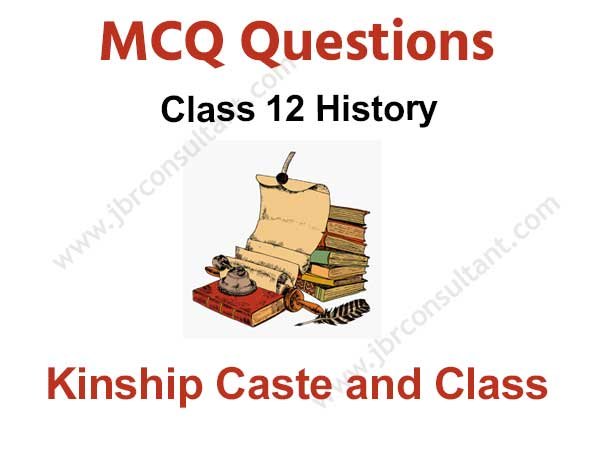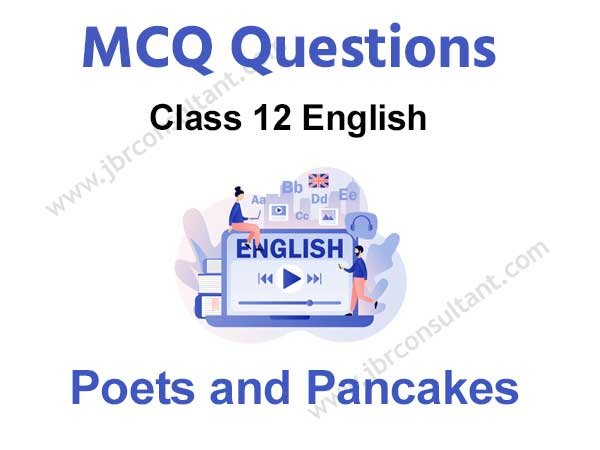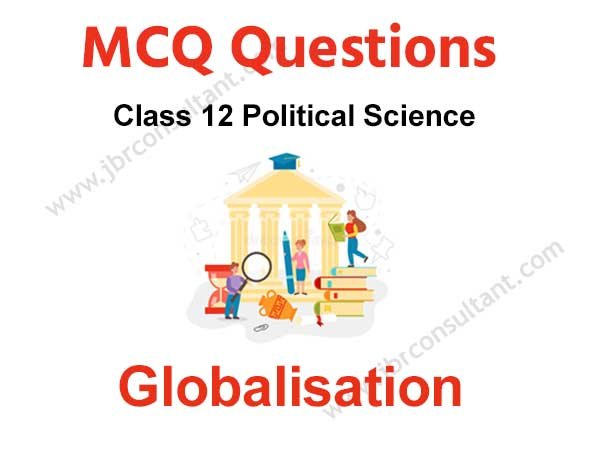Kinship Caste And Class Class 12 MCQ is one of the best strategies to prepare for the CBSE Class 12 Board exam. If you want to complete a grasp concept or work on one’s score, there is no method except constant practice. Students can improve their speed and accuracy by doing more MCQ on Kinship Caste And Class class 12, which will help them all through their board test.
Kinship Caste And Class Class 12 MCQ Questions with Answer
Class 12 History MCQ with answers are given here to chapter 3 Kinship Caste And Class. These MCQs are based on the latest CBSE board syllabus and relate to the latest Class 12 History syllabus. By Solving these Class 12 MCQs, you will be able to analyze all of the concepts quickly in the chapter and get ready for the Class 12 Annual exam.
Learn Class 12 Kinship Caste And Class MCQs with answers pdf free download according to the latest CBSE and NCERT syllabus. Students should prepare for the examination by solving CBSE Class 12 History Kinship Caste And Class MCQ with answers given below.
Question 1: What does the Sanskrit word ‘Kula’ define?
(a) Neighbours
(b) Families
(c) Deities
(d) None of these
Answer
B
Question 2: How many verses are there in Mahabharata?
(a) One lakh
(b) 20000
(c) 50000
(d) More than one lakh
Answer
D
Question 3: Consider the following statements about Mahabharata:
(a) Historians have set aside the traditions as described in Mahabharata.
(b) It has around 10,000 verses.
(c) The main theme of Mahabharata is about the warring princes across India.
(d) Its critical edition was started by K. R. Mangalam in 1919 CE.
State which of the above statements are correct?
(a) Only (a)
(b) (a) and (2)
(c) (a), (2) and (4)
(d) None of these
Answer
D
Question 4: Which one of the following statement is not true regarding the word, ‘patriliny’ ?
(a) Patriliny had not existed prior to the composition of the epic, Mahabharata. The central story of the Mahabharata established the idea.
(b) Patriliny means tracing descent from father to son, grandson and so on.
(c) Most ruling dynasties (c. sixth century BCE onwards) claimed to follow this system, although there were variations in practice.
(d) The concern with patriliny was not unique to ruling families. It is evident in mantras in ritual texts such as the Rigveda.
Answer
A
Question 5: Consider the following statements regarding the rules of the marriage during the Early Societies:
I. At that time sons were important for the continuity of the patrilineage, daughters were viewed rather differently within this framework.
II. At the same time, marrying them into families outside the kin was considered desirable.
III. The system of exogamy gave rise to the belief that kanyadana or the gift of a daughter in marriage was an important religious duty of the father.
Which of the following statement(s) is/are correct?
(a) Only I
(b) I and II
(c) I and III
(d) All of the above
Answer
D
Question 6: Under the leadership of a noted Indian Sanskritist,V.S. Sukthankar and his team comprising dozens of scholars initiated the task of preparing a critical edition of the Mahabharata. Which of the following statements is incorrect about the critical edition of Mahabharata?
(a) The team worked out a method of comparing verses from each manuscript.
(b) They selected the verses that appeared common to most versions and published these in several volumes, running into over 13,000 pages.
(c) These variations were documented in footnotes and appendices to the main text.
(d) The project took 49 years to complete.
Answer
D
Question 7: Ekalavya belonged to the category of:
(a) Vanik
(b) Mlechchha
(c) Brahmana
(d) Nishada
Answer
D
Question 8: Which of the following statement is incorrect about the meaning of Endogamy?
(a) Endogamy refers to marriage outside the unit.
(b) Endogamy refers to marriage within a unit – this could be a kin group, caste, or a group living in the same locality.
(c) It is the practice of a man having several wives.
(d) It is the practice of a woman having several husbands.
Answer
B
Question 9: Which among the following was a strategy adopted by the Brahmanas to enforce the varna order?
(a) Assert that varna order was a human creation.
(b) Advised kings to punish those who violated these norms.
(c) Persuaded people that their status was determined by birth.
(d) Persuaded people that their status was determined by occupations they practised.
Answer
C
Question 10: Which one of the following statements is incorrect about the duties as laid down in Manusmriti for the Chandalas?
(a) They had to live on the outskirts of the village.
(b) They had to use discarded utensils.
(c) They were supposed to wear old clothes of the villagers and ornaments made from shells.
(d) It was their duty to serve as executioner and dispose of the bodies of those who had no relatives.
Answer
C
Question 11: According to The Dharmasutras and Dharmashastras Kshatriyas were to engage in ___________
(a) warfare, protect people and administer justice, study the Vedas, get sacrifices performed, and make gifts
(b) study and teach the Vedas, perform sacrifices and get sacrifices performed, and give and receive gifts.
(c) in agriculture, pastoralism and trade.
(d) serving the BrahmAnswer :
Answer
A
Question 12: Which foreign traveller wrote in his account that“untouchables” had to sound a clapper in the streets so that people could avoid seeing them.”?
(a) Fa-Hien or Fa-Xian R
(b) Hiuen-Tsang
(c) Marco Polo
(d) Megasthenes,
Answer
A
Question 13: Which of the following pairs is not correctly matched?
(a) Kouravas–Son of Gandhari
(b) Ekalavya–Chandala
(c) Pandavas–Sons of Pandu
(d) Suvarnakaras–Goldsmith
Answer
B
Question 14: A forest-dwelling or a hunting community is called
(a) Nishada
(b) Chandala
(c) Suvarnakaras
(d) Shudras
Answer
A
Question 15: According to Manusmriti, for women, there are six means of acquiring wealth. Which one of the following statement is incorrect regarding those means?
(a) She could acquire wealth through any subsequent gift and whatever her “affectionate” husband might give her.
(b) She could acquire wealth through bridal procession .
(c) She could acquire wealth as a token of affection, and what she got from her brother, mother or father.
(d) She could acquire wealth after her husband’s death.
Answer
D
Question 16: Women were allowed to retain the gifts they received on the occasion of their marriage as:
(a) stridhana
(b) manusmriti
(c) biksha
(d) None of These
Answer
A
Question 17: Which of the following was one of the occupations of Kshatriyas?
(a) Perform sacrifices and give gifts
(b) To teach Vedas
(c) Trade
(d) Agriculture
Answer
A
Question 18: Which of the following strategies were evolved by Brahmanas to enforce the norms of Varna order from c. 600 BCE to 600 CE?
(a) Brahmanas used to emphasise that the varna system is divine.
(b) Brahmanas tried to convince people that their occupation and status are determined by birth.
(c) Brahmanas advised the kings to ensure that people follow the norms of the varna system within the kingdom.
(d) All of these.
Answer
D
Whoever needs to take the CBSE Class 12 Board Exam should look at this MCQ. To the Students who will show up in CBSE Class 12 History Board Exams, It is suggested to practice more and more questions. Aside from the sample paper you more likely had solved. These Kinship Caste And Class Class 12 MCQ are ready by the subject specialists themselves.
Question 19: Sutta Patika is a text belong to ___________ religion.
(a) Hindu
(b) Buddhist
(c) Jain
(d) None of this.
Answer
B
Question 20: Which of the following statement is correct regarding the interpretation of Sutta Pitaka?
(a) Originally human beings did not have fully evolved bodily forms, nor was the world of plants fully developed.
(b) All beings lived in an idyllic state of peace, taking from nature only what they needed for each meal.
(c) There was a gradual deterioration of this state as human beings became increasingly greedy, vindictive and deceitful.
(d) Human beings were not responsible for the creation of the system, they could not change it in future.
Which of the following statement(s) is/are correct?
(a) Only a
(b) a and b
(c) a, b, c
(d) Only d
Answer
C
Question 21: Marriage within a unit, a kin group, caste or a group living in the same locality, is called
(a) endogamy.
(b) exogamy.
(c) polygyny.
(d) polyandry.
Answer
A
Question 22: Which of the following statement is not the correct interpretation of mahasammata?
(a) The idea of leadership was based purely on choice.
(b) The institution of kingship was based on the choice of God.
(c) Recognition of human agency in creating and institutionalising economic and social relations.
(d) Human beings were responsible for the creation of the system, they could also change it in future.
Answer
B
Question 23: Puranaruru is one of the anthologies of poems. To which literature does it belongs?
(a) Tamil Sangam literature.
(b) Buddhist literature
(c) Sanskrit literature
(d) Bengali literature
Answer
A
Question 24: Shakas who came from Central Asia were regarded by the Brahmanas as
(a) Dasas
(b) Untouchables
(c) Mlechchhas
(d) Aryans
Answer
C
Question 25: The janapada which was inhabited by the cousins Pandavas and Kauravas was that of
(a) Shurasenas.
(b) Mallas.
(c) Sakyas.
(d) Kurus.
Answer
D
Question 26: Historians consider several elements when they analyse texts such as:
(a) They examine the language of the texts whether they were written in Prakrit, Pali or Tamil, languages that were probably used by ordinary people, or in Sanskrit, a language meant almost exclusively for priests and elites.
(b) They also consider about the kind of texts like whether these were mantras, learnt and chanted by ritual specialists, or stories that people could have read, or heard.
(c) They also consider author’s perspective about the text.
(d) They try and ascertain the possible date of the composition of the texts as well as the place where they may have been composed.
Which of the above statement(s) is/are correct?
(a) Only (a)
(b) (a) and (b)
(c) (a) and (c)
(d) All of the above
Answer
D
Question 27: The classification of people, in the name of gotras in Hindu religion, was practised from c. 1000 BCE onwards, by the
(a) Brahmanas.
(b) Kshatriyas.
(c) Vaishyas.
(d) Shudras.
Answer
A
Question 28: The word ‘Didactic’,means R
(a) something that is meant for purposes of instruction.
(b) The description of events in a story
(c) Noticeable or sudden and often surprising
(d) Extremely mournful, melancholy or pathetic.
Answer
A
Question 29: The original story of Mahabharata was probably composed by
(a) Lord Ganesha
(b) Rishi Veda Vyasa
(c) Charioteer-bards known as sutas.
(d) Lord Brahama
Answer
C
Question 30: Who wrote the short story,“Kunti O Nishadi”?
(a) Mahadevi Verma
(b) Mahashweta Devi
(c) Krishna Sobti
(d) Ashapurna Devi
Answer
B
Question 31: Panini’s ‘Ashtadhyayi’ is a work on
(a) Sanskrit grammar.
(b) Sanskrit history.
(c) Sanskrit mantras.
(d) Sanskrit plays.
Answer
A
Question 32: Identify the years span, when an archeologist B.B.Lal excavated at a village named Hastinapura in Meerut (Uttar Pradesh)?
(a) 1951–52
(b) 1962–63
(c) 1970–71
(d) 1950–51
Answer
A
Question 33: The Brahmanas considered some people as being outside the system by classifying certain social categories as _______.
(a) Kinfolk
(b) Varnas
(c) Untouchable
(d) Nishada
Answer
C
Question 34: What was the object of the team of V.S. Sukthankar?
(a) Prepare critical edition of Mahabharata
(b) Translate Mahabharata in the English language
(c) Prepare critical edition of Manusmriti
(d) Translate Manusmriti in Tamil
Answer
A
Question 35: According to the ______, the paternal estate was to be divided equally amongst sons after the death of the parents.
(a) Varnas
(b) Varnas
(c) Manusmriti
(d) Mahabharata
Answer
C
Question 36: Present-day historians suggest that the fact that the author(s) describe a polyandrous union indicates that polyandry may have been prevalent amongst ruling elites at some point of time.
(a) Some historians note that while the practice of polyandry may have seemed unusual or even undesirable from the Brahmanical point of view, it was (and is) prevalent in the Himalayan region.
(b) There may have been a shortage of women during times of warfare, and this led to polyandry. In other words, it was attributed to a situation of crisis.
(c) The author(s) choose to associate this practice with the central characters of the Mahabharata because sometimes creative literature often has its own narrative requirements and does not always literally reflect social realities.
Which of the above statement(s) is/are correct?
(a) Only (a)
(b) (a) and (b)
(c) (a) and (c)
(d) All of the above
Answer
D

You can easily get good marks If you study with the help of Class 12 Kinship Caste And Class MCQ. We trust that information provided is useful for you. NCERT Kinship Caste And Class Class 12 MCQ PDF Free Download would without a doubt create positive results.
We hope the information shared above in regards to MCQ on Kinship Caste And Class Class 12 with Answers has been helpful to you. if you have any questions regarding CBSE Class 12 History Solutions MCQs Pdf, write a comment below and we will get back to you as soon as possible.
Frequently Asked Question (FAQs)
How many MCQ questions are there in Class 12 chapter 3 History?
In Class 12 chapter 3 History, we have provided 36 Important MCQ Questions, But in the future, we will add more MCQs so that you can get good marks in the Class 12 exam.
Can we score good marks in Class 12 History with the help of Kinship Caste And Class MCQ Questions?
Yes, MCQ Question is one of the best strategies to make your preparation better for the CBSE Board Exam. It also helps to know the student’s basic understanding of each chapter. So, You can score good marks in the Class 12 History exam.

